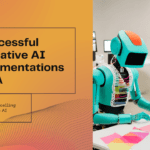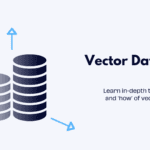Retrieval-Augmented Generation (RAG) frameworks have surged in popularity, revolutionizing how language models access and process information. In this comprehensive article, we delve into the growing prominence of RAG, reflecting on its widespread adoption across diverse industries. We aim to demystify this framework by dissecting its core components, intricacies, and inner workings. From understanding its retrieval and generative models to unraveling the advantages and practical use cases, join us on this journey through the rising prominence and multifaceted applications of RAG frameworks.
Understanding the Framework
The Retrieval-Augmented Generation (RAG) framework, rooted in two pivotal components – the retrieval and generative models, dynamically elevates language models. Collaboratively, they access external repositories, sourcing pertinent data for cohesive narrative structuring. This integration enables RAG to seamlessly synthesize external information, fostering contextually rich responses. The retrieval model serves as a ‘librarian,’ fetching relevant data, while the generative model, akin to a skilled ‘writer,’ transforms this retrieved data into actionable, comprehensible content. Together, they fortify language models with up-to-date, external knowledge, enhancing their ability to produce accurate and contextually aligned outputs.
Exploring the Components
The RAG framework is composed of two vital components, each playing a distinctive yet interconnected role in enhancing language models:
Retrieval Model
- Function: This specialized ‘librarian’ scours vast external repositories, employing sophisticated algorithms to extract the most relevant information.
- Operation: Operating dynamically, it continually sifts through external datasets, ensuring real-time updates without necessitating complete model retraining. This agility enables the model to adapt swiftly to changing information landscapes.
- Purpose: Its primary goal is to fetch pertinent data, ensuring that the retrieved information remains up-to-date and aligns with the model’s response generation process. This dynamic operation ensures that the model integrates the most recent and contextually relevant data into its outputs.
Generative Model
- Function: Similar to a skilled ‘writer,’ this component structures the retrieved data into cohesive and actionable narratives.
- Integration: It integrates the retrieved data seamlessly with user queries, synthesizing it into contextually rich and understandable responses.
- Strengths: Its proficiency lies in crafting responses that are not only accurate but also imbued with context. By amalgamating the retrieved data with user inquiries, it ensures that the generated output is both informative and easily digestible.
These components operate collaboratively within the RAG framework. The Retrieval Model acts as a dynamic information gatekeeper, continually updating and providing relevant data to the Generative Model. The Generative Model, in turn, transforms this data into contextually relevant and actionable content, ultimately enhancing the language model’s ability to generate accurate and nuanced responses. This collaboration ensures that the model is well-equipped to deliver information that is both up-to-date and contextually rich.
Mechanisms at Work
The mechanisms at work within the RAG framework harmonize the functions of its two core components, the Retrieval Model and the Generative Model, to achieve contextual richness and accuracy in language generation.
- Retrieval Mechanism:
- Dynamic Data Access: The Retrieval Model dynamically fetches information from diverse external sources. Utilizing algorithms, it navigates vast datasets, ensuring real-time updates without requiring extensive model retraining.
- Relevance Ranking: Algorithms rank and extract the most pertinent data, aligning it with user queries and contextual relevance. This ensures that the retrieved information remains current and directly contributes to the model’s response generation process.
- Integration and Generation:
- Structuring Retrieved Data: The Generative Model adeptly structures the retrieved data into coherent narratives. It assimilates this information with user queries, integrating it seamlessly into the generation process.
- Contextual Synthesis: This model synthesizes the retrieved data, ensuring that responses are contextually rich and relevant to user inquiries. By interweaving the retrieved information with user inputs, it crafts responses that are both accurate and contextually nuanced.
- Real-time Adaptability: Continuous Adaptation: RAG’s design facilitates continuous adaptation to changing information landscapes. The dynamic nature of the Retrieval Model ensures that the system remains agile, capable of accessing and integrating the latest information without disruptions or extensive retraining.
- Accuracy and Contextuality: Grounded Responses: By grounding each response in retrieved evidence, RAG minimizes inaccuracies and fabrications in generated content. This mechanism ensures that outputs are factually accurate and aligned with the context provided by retrieved data.
These mechanisms work synergistically, empowering RAG to dynamically source and integrate external knowledge while generating responses that are not only accurate but also contextually relevant. By combining dynamic data access with a structured generation process, RAG ensures that the language model produces reliable and informative outputs.
Benefits of RAG
The Retrieval-Augmented Generation (RAG) framework offers a multitude of benefits that significantly elevate the capabilities of language models.
- Access to Dynamic Information: RAG excels in accessing and integrating real-time, dynamic external data sources. This ensures that the model’s responses are always up-to-date and aligned with the latest information.
- Contextual Relevance: By retrieving and integrating external knowledge, RAG ensures that generated responses are contextually rich and relevant. This contextual understanding enhances the accuracy and usefulness of the generated content.
- Reduced Model Retraining: The dynamic nature of the Retrieval Model in RAG allows for continuous updates without the need for frequent model retraining. This agility saves time and computational resources while keeping the model current.
- Minimized Fabrication and Inaccuracies: Grounding responses in retrieved evidence reduces the likelihood of inaccuracies or fabrications in generated content. This mechanism ensures that the model produces more reliable and factually accurate outputs.
- Adaptability to Diverse Domains: RAG’s ability to access external knowledge sources makes it adaptable to various domains and industries. It can cater to specific information needs across a wide spectrum of applications.
- Enhanced User Trust: By providing transparent insights into the retrieval and integration process, RAG fosters trust in the generated responses. This transparency enhances user confidence in the accuracy and reliability of the model’s outputs.
- Efficiency in Complex Tasks: RAG simplifies complex tasks by amalgamating information from multiple sources. This capability is particularly useful in research, customer support, news summarization, and other information-intensive domains.
- Real-time Adaptation: The framework’s ability to continuously query and update external data sources ensures that the model remains adaptable to evolving information landscapes, maintaining relevance over time.
- Improved Decision Support: Access to diverse and up-to-date information sources enables RAG to assist in decision-making processes across various domains, such as finance, healthcare, and legal sectors.
Overall, RAG’s integration of external knowledge sources empowers language models with a depth of information, fostering accuracy, adaptability, and contextuality in generated responses across diverse applications and industries.
RAG vs. Fine-Tuning
Comparing Retrieval-Augmented Generation (RAG) and fine-tuning reveals two distinct yet complementary methodologies in enhancing language models.
RAG
RAG is a framework that leverages retrieval mechanisms to integrate external knowledge sources into language models. It excels in accessing dynamic external data, ensuring up-to-date information without frequent model retraining. The retrieval model actively fetches pertinent information from various sources, allowing the generative model to synthesize contextually rich responses. RAG’s strength lies in its agility, offering real-time updates and contextual accuracy by integrating external data sources seamlessly.
Fine-Tuning
Fine-tuning involves adapting pre-trained language models to specific tasks or domains. It tailors models by training them on task-specific or domain-specific data, enabling them to perform better in specialized areas. This process allows the model to adjust its parameters to align with specific nuances, vocabularies, or tones. While fine-tuning enhances model performance for targeted tasks, it typically requires static training data and might become quickly outdated in rapidly changing data landscapes.
Comparative Analysis
- Adaptability to Dynamic Data: RAG excels in dynamic data environments, continuously querying external sources for updated information without frequent retraining. In contrast, fine-tuned models become static snapshots during training, potentially becoming outdated in dynamic scenarios.
- Utilizing External Knowledge: RAG is designed to access and leverage external data sources for generating responses, making it flexible and adaptable. Fine-tuning allows models to learn domain-specific knowledge but might not be practical for frequently changing data sources.
- Customization and Specificity: Fine-tuning offers deep alignment with specific styles or expertise, allowing customization to domain-specific nuances. RAG primarily focuses on retrieving information without inherent adaptation of linguistic style or domain specificity.
- Hallucination and Response Accuracy: RAG is less prone to fabricating responses as it grounds each output in retrieved evidence, minimizing the chances of inaccuracies. Fine-tuned models might fabricate responses when faced with unfamiliar inputs.
- Transparency and Interpretability: RAG provides transparency by breaking down response generation into distinct stages, fostering trust in outputs. Fine-tuning, being more specific, might operate as a black box, making the reasoning behind responses more opaque.
- Cost and Technical Complexity: Fine-tuning might be more cost-effective for smaller models and demands less technical complexity. RAG, while agile and adaptable, might require moderate to advanced technical expertise, especially in integrating and handling external data sources.
In essence, while fine-tuning offers specificity and domain adaptation, RAG shines in accessing real-time external knowledge, ensuring dynamic and accurate responses. Their combined utilization can maximize language model performance, addressing the limitations of each methodology and providing comprehensive language processing capabilities.
Top Use Cases of RAG
The Retrieval-Augmented Generation (RAG) framework presents a versatile approach in enhancing language models by integrating external knowledge sources. Its applicability spans across various domains, offering invaluable solutions to diverse challenges. Here are some top use cases of RAG.
- Real-Time News Summarization
- RAG’s ability to fetch and integrate the latest information makes it ideal for summarizing rapidly evolving news landscapes accurately. It can compile concise and contextually rich summaries by accessing diverse sources in real-time, offering comprehensive insights to users.
- Automated Customer Support and Service
- Leveraging RAG in customer service settings allows for precise and up-to-date responses to customer queries. By accessing databases, documents, or FAQs in real-time, RAG ensures that customer support systems offer accurate and timely solutions, enhancing customer satisfaction and efficiency.
- Complex Research Tasks
- Research tasks often demand comprehensive data synthesis from multiple sources. RAG’s capability to integrate information from diverse external repositories proves invaluable in conducting complex research, allowing for more informed analyses and conclusions.
- Medical and Healthcare Applications
- In the medical field, RAG can access a wide range of updated medical literature, patient records, and research findings. This enables the generation of contextually relevant responses for medical inquiries, aiding healthcare professionals in decision-making processes.
- Legal and Compliance Assistance
- RAG can access legal databases, case law, and regulatory documents to provide accurate and up-to-date information in legal settings. This facilitates legal professionals in research, compliance checks, and accessing relevant precedents efficiently.
- Education and E-Learning
- Integrating RAG in educational platforms can enhance learning experiences by accessing diverse learning materials, textbooks, and academic sources. It can provide contextually rich explanations, answers, and learning resources to students in real-time.
- Financial Analysis and Decision Support
- RAG’s ability to access financial reports, market trends, and economic data makes it valuable in financial analysis and decision-making processes. It can provide contextually accurate information for investment analysis, risk assessment, and forecasting.
- Content Creation and Writing Assistance
- In content creation, RAG can assist writers by providing relevant information from diverse sources. It can aid in research, fact-checking, and generating contextually appropriate content, enhancing the quality and accuracy of written materials.
These use cases illustrate RAG’s versatility in various industries, demonstrating its potential to revolutionize information retrieval, decision-making processes, and user interactions by integrating external knowledge seamlessly into language models.
Conclusion
Retrieval-Augmented Generation marks a paradigm shift, enriching language models by seamlessly integrating external knowledge. Its adaptability to changing data landscapes, coupled with contextual accuracy, positions RAG as a transformative force in AI-powered language processing. This framework’s ability to fuse dynamic external data with model-generated content signifies a groundbreaking advancement, promising a future where language models deliver more relevant, accurate, and adaptable responses.



